Mingxin Li
Towards Universal Video Retrieval: Generalizing Video Embedding via Synthesized Multimodal Pyramid Curriculum
Oct 31, 2025Abstract:The prevailing video retrieval paradigm is structurally misaligned, as narrow benchmarks incentivize correspondingly limited data and single-task training. Therefore, universal capability is suppressed due to the absence of a diagnostic evaluation that defines and demands multi-dimensional generalization. To break this cycle, we introduce a framework built on the co-design of evaluation, data, and modeling. First, we establish the Universal Video Retrieval Benchmark (UVRB), a suite of 16 datasets designed not only to measure performance but also to diagnose critical capability gaps across tasks and domains. Second, guided by UVRB's diagnostics, we introduce a scalable synthesis workflow that generates 1.55 million high-quality pairs to populate the semantic space required for universality. Finally, we devise the Modality Pyramid, a curriculum that trains our General Video Embedder (GVE) by explicitly leveraging the latent interconnections within our diverse data. Extensive experiments show GVE achieves state-of-the-art zero-shot generalization on UVRB. In particular, our analysis reveals that popular benchmarks are poor predictors of general ability and that partially relevant retrieval is a dominant but overlooked scenario. Overall, our co-designed framework provides a practical path to escape the limited scope and advance toward truly universal video retrieval.
$\text{E}^2\text{Rank}$: Your Text Embedding can Also be an Effective and Efficient Listwise Reranker
Oct 26, 2025Abstract:Text embedding models serve as a fundamental component in real-world search applications. By mapping queries and documents into a shared embedding space, they deliver competitive retrieval performance with high efficiency. However, their ranking fidelity remains limited compared to dedicated rerankers, especially recent LLM-based listwise rerankers, which capture fine-grained query-document and document-document interactions. In this paper, we propose a simple yet effective unified framework $\text{E}^2\text{Rank}$, means Efficient Embedding-based Ranking (also means Embedding-to-Rank), which extends a single text embedding model to perform both high-quality retrieval and listwise reranking through continued training under a listwise ranking objective, thereby achieving strong effectiveness with remarkable efficiency. By applying cosine similarity between the query and document embeddings as a unified ranking function, the listwise ranking prompt, which is constructed from the original query and its candidate documents, serves as an enhanced query enriched with signals from the top-K documents, akin to pseudo-relevance feedback (PRF) in traditional retrieval models. This design preserves the efficiency and representational quality of the base embedding model while significantly improving its reranking performance. Empirically, $\textrm{E}^2\text{Rank}$ achieves state-of-the-art results on the BEIR reranking benchmark and demonstrates competitive performance on the reasoning-intensive BRIGHT benchmark, with very low reranking latency. We also show that the ranking training process improves embedding performance on the MTEB benchmark. Our findings indicate that a single embedding model can effectively unify retrieval and reranking, offering both computational efficiency and competitive ranking accuracy.
Qwen3 Embedding: Advancing Text Embedding and Reranking Through Foundation Models
Jun 05, 2025


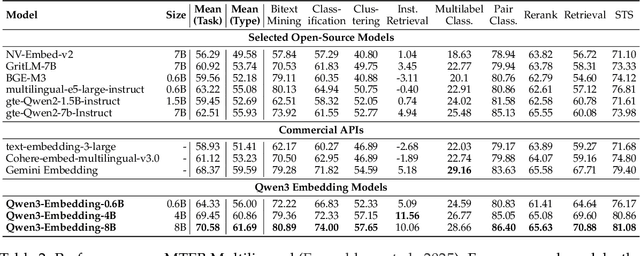
Abstract:In this work, we introduce the Qwen3 Embedding series, a significant advancement over its predecessor, the GTE-Qwen series, in text embedding and reranking capabilities, built upon the Qwen3 foundation models. Leveraging the Qwen3 LLMs' robust capabilities in multilingual text understanding and generation, our innovative multi-stage training pipeline combines large-scale unsupervised pre-training with supervised fine-tuning on high-quality datasets. Effective model merging strategies further ensure the robustness and adaptability of the Qwen3 Embedding series. During the training process, the Qwen3 LLMs serve not only as backbone models but also play a crucial role in synthesizing high-quality, rich, and diverse training data across multiple domains and languages, thus enhancing the training pipeline. The Qwen3 Embedding series offers a spectrum of model sizes (0.6B, 4B, 8B) for both embedding and reranking tasks, addressing diverse deployment scenarios where users can optimize for either efficiency or effectiveness. Empirical evaluations demonstrate that the Qwen3 Embedding series achieves state-of-the-art results across diverse benchmarks. Notably, it excels on the multilingual evaluation benchmark MTEB for text embedding, as well as in various retrieval tasks, including code retrieval, cross-lingual retrieval and multilingual retrieval. To facilitate reproducibility and promote community-driven research and development, the Qwen3 Embedding models are publicly available under the Apache 2.0 license.
GME: Improving Universal Multimodal Retrieval by Multimodal LLMs
Dec 22, 2024



Abstract:Universal Multimodal Retrieval (UMR) aims to enable search across various modalities using a unified model, where queries and candidates can consist of pure text, images, or a combination of both. Previous work has attempted to adopt multimodal large language models (MLLMs) to realize UMR using only text data. However, our preliminary experiments demonstrate that more diverse multimodal training data can further unlock the potential of MLLMs. Despite its effectiveness, the existing multimodal training data is highly imbalanced in terms of modality, which motivates us to develop a training data synthesis pipeline and construct a large-scale, high-quality fused-modal training dataset. Based on the synthetic training data, we develop the General Multimodal Embedder (GME), an MLLM-based dense retriever designed for UMR. Furthermore, we construct a comprehensive UMR Benchmark (UMRB) to evaluate the effectiveness of our approach. Experimental results show that our method achieves state-of-the-art performance among existing UMR methods. Last, we provide in-depth analyses of model scaling, training strategies, and perform ablation studies on both the model and synthetic data.
A hybrid framework for effective and efficient machine unlearning
Dec 19, 2024Abstract:Recently machine unlearning (MU) is proposed to remove the imprints of revoked samples from the already trained model parameters, to solve users' privacy concern. Different from the runtime expensive retraining from scratch, there exist two research lines, exact MU and approximate MU with different favorites in terms of accuracy and efficiency. In this paper, we present a novel hybrid strategy on top of them to achieve an overall success. It implements the unlearning operation with an acceptable computation cost, while simultaneously improving the accuracy as much as possible. Specifically, it runs reasonable unlearning techniques by estimating the retraining workloads caused by revocations. If the workload is lightweight, it performs retraining to derive the model parameters consistent with the accurate ones retrained from scratch. Otherwise, it outputs the unlearned model by directly modifying the current parameters, for better efficiency. In particular, to improve the accuracy in the latter case, we propose an optimized version to amend the output model with lightweight runtime penalty. We particularly study the boundary of two approaches in our frameworks to adaptively make the smart selection. Extensive experiments on real datasets validate that our proposals can improve the unlearning efficiency by 1.5$\times$ to 8$\times$ while achieving comparable accuracy.
When Text Embedding Meets Large Language Model: A Comprehensive Survey
Dec 12, 2024



Abstract:Text embedding has become a foundational technology in natural language processing (NLP) during the deep learning era, driving advancements across a wide array of downstream tasks. While many natural language understanding challenges can now be modeled using generative paradigms and leverage the robust generative and comprehension capabilities of large language models (LLMs), numerous practical applications, such as semantic matching, clustering, and information retrieval, continue to rely on text embeddings for their efficiency and effectiveness. In this survey, we categorize the interplay between LLMs and text embeddings into three overarching themes: (1) LLM-augmented text embedding, enhancing traditional embedding methods with LLMs; (2) LLMs as text embedders, utilizing their innate capabilities for embedding generation; and (3) Text embedding understanding with LLMs, leveraging LLMs to analyze and interpret embeddings. By organizing these efforts based on interaction patterns rather than specific downstream applications, we offer a novel and systematic overview of contributions from various research and application domains in the era of LLMs. Furthermore, we highlight the unresolved challenges that persisted in the pre-LLM era with pre-trained language models (PLMs) and explore the emerging obstacles brought forth by LLMs. Building on this analysis, we outline prospective directions for the evolution of text embedding, addressing both theoretical and practical opportunities in the rapidly advancing landscape of NLP.
Improving General Text Embedding Model: Tackling Task Conflict and Data Imbalance through Model Merging
Oct 19, 2024



Abstract:Text embeddings are vital for tasks such as text retrieval and semantic textual similarity (STS). Recently, the advent of pretrained language models, along with unified benchmarks like the Massive Text Embedding Benchmark (MTEB), has facilitated the development of versatile general-purpose text embedding models. Advanced embedding models are typically developed using large-scale multi-task data and joint training across multiple tasks. However, our experimental analysis reveals two significant drawbacks of joint training: 1) Task Conflict: Gradients from different tasks interfere with each other, leading to negative transfer. 2) Data Imbalance: Disproportionate data distribution introduces biases that negatively impact performance across tasks. To overcome these challenges, we explore model merging-a technique that combines independently trained models to mitigate gradient conflicts and balance data distribution. We introduce a novel method, Self Positioning, which efficiently searches for optimal model combinations within the interpolation space of task vectors using stochastic gradient descent. Our experiments demonstrate that Self Positioning significantly enhances multi-task performance on the MTEB dataset, achieving an absolute improvement of 0.7 points. It outperforms traditional resampling methods while reducing computational costs. This work offers a robust approach to building generalized text embedding models with superior performance across diverse embedding-related tasks.
Towards Better Understanding of Contrastive Sentence Representation Learning: A Unified Paradigm for Gradient
Feb 28, 2024Abstract:Sentence Representation Learning (SRL) is a crucial task in Natural Language Processing (NLP), where contrastive Self-Supervised Learning (SSL) is currently a mainstream approach. However, the reasons behind its remarkable effectiveness remain unclear. Specifically, in other research fields, contrastive SSL shares similarities in both theory and practical performance with non-contrastive SSL (e.g., alignment & uniformity, Barlow Twins, and VICReg). However, in SRL, contrastive SSL outperforms non-contrastive SSL significantly. Therefore, two questions arise: First, what commonalities enable various contrastive losses to achieve superior performance in SRL? Second, how can we make non-contrastive SSL, which is similar to contrastive SSL but ineffective in SRL, effective? To address these questions, we start from the perspective of gradients and discover that four effective contrastive losses can be integrated into a unified paradigm, which depends on three components: the Gradient Dissipation, the Weight, and the Ratio. Then, we conduct an in-depth analysis of the roles these components play in optimization and experimentally demonstrate their significance for model performance. Finally, by adjusting these components, we enable non-contrastive SSL to achieve outstanding performance in SRL.
Narrowing the Gap between Supervised and Unsupervised Sentence Representation Learning with Large Language Model
Sep 12, 2023Abstract:Sentence Representation Learning (SRL) is a fundamental task in Natural Language Processing (NLP), with Contrastive learning of Sentence Embeddings (CSE) as the mainstream technique due to its superior performance. An intriguing phenomenon in CSE is the significant performance gap between supervised and unsupervised methods, even when their sentence encoder and loss function are the same. Previous works attribute this performance gap to differences in two representation properties (alignment and uniformity). However, alignment and uniformity only measure the results, which means they cannot answer "What happens during the training process that leads to the performance gap?" and "How can the performance gap be narrowed?". In this paper, we conduct empirical experiments to answer these "What" and "How" questions. We first answer the "What" question by thoroughly comparing the behavior of supervised and unsupervised CSE during their respective training processes. From the comparison, We observe a significant difference in fitting difficulty. Thus, we introduce a metric, called Fitting Difficulty Increment (FDI), to measure the fitting difficulty gap between the evaluation dataset and the held-out training dataset, and use the metric to answer the "What" question. Then, based on the insights gained from the "What" question, we tackle the "How" question by increasing the fitting difficulty of the training dataset. We achieve this by leveraging the In-Context Learning (ICL) capability of the Large Language Model (LLM) to generate data that simulates complex patterns. By utilizing the hierarchical patterns in the LLM-generated data, we effectively narrow the gap between supervised and unsupervised CSE.
Emergent Incident Response for Unmanned Warehouses with Multi-agent Systems*
May 29, 2023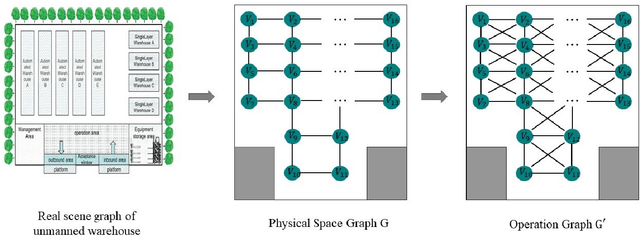
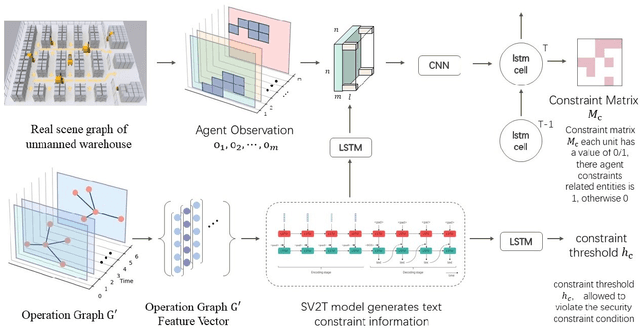
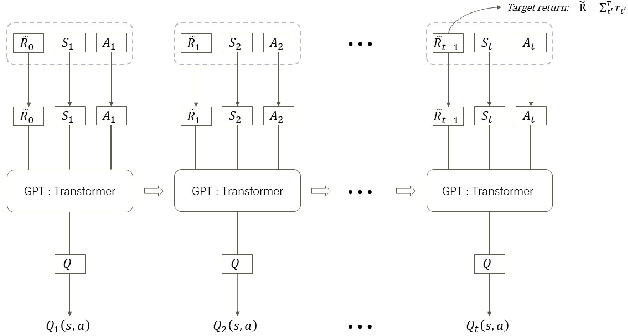
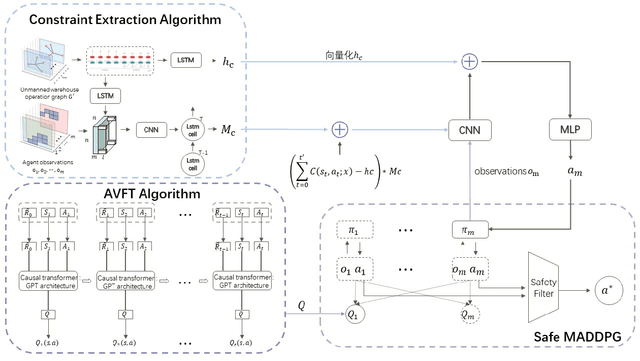
Abstract:Unmanned warehouses are an important part of logistics, and improving their operational efficiency can effectively enhance service efficiency. However, due to the complexity of unmanned warehouse systems and their susceptibility to errors, incidents may occur during their operation, most often in inbound and outbound operations, which can decrease operational efficiency. Hence it is crucial to to improve the response to such incidents. This paper proposes a collaborative optimization algorithm for emergent incident response based on Safe-MADDPG. To meet safety requirements during emergent incident response, we investigated the intrinsic hidden relationships between various factors. By obtaining constraint information of agents during the emergent incident response process and of the dynamic environment of unmanned warehouses on agents, the algorithm reduces safety risks and avoids the occurrence of chain accidents; this enables an unmanned system to complete emergent incident response tasks and achieve its optimization objectives: (1) minimizing the losses caused by emergent incidents; and (2) maximizing the operational efficiency of inbound and outbound operations during the response process. A series of experiments conducted in a simulated unmanned warehouse scenario demonstrate the effectiveness of the proposed method.
 Add to Chrome
Add to Chrome Add to Firefox
Add to Firefox Add to Edge
Add to Edge